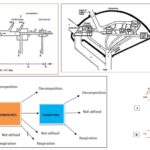Neuroscience 17 Views 1 Answers
Sourav PanLv 9September 23, 2024
What two functions do proteins in the neuronal membrane perform to establish and maintain the resting membrane potential?
What two functions do proteins in the neuronal membrane perform to establish and maintain the resting membrane potential?
Please login to save the post
Please login to submit an answer.
Sourav PanLv 9May 15, 2025
Proteins in the neuronal membrane perform two primary functions to establish and maintain the resting membrane potential:
- Ion Pumps: These proteins actively transport ions across the membrane, creating and maintaining concentration gradients. The sodium-potassium pump is particularly important, as it exchanges three sodium ions (Na⁺) out of the cell for two potassium ions (K⁺) into the cell. This process requires ATP and establishes a high concentration of K⁺ inside the neuron and a high concentration of Na⁺ outside, which is crucial for the resting membrane potential.
- Ion Channels: These proteins provide pathways for ions to move passively across the membrane. Potassium channels are especially significant because the membrane is more permeable to K⁺ at rest. These channels allow K⁺ to flow out of the neuron, driven by the concentration gradient, which contributes to a negative membrane potential. The presence of sodium channels, although less permeable at rest, allows a small influx of Na⁺, influencing the resting potential and responsiveness of the neuron to stimuli.
0
0 likes
- Share on Facebook
- Share on Twitter
- Share on LinkedIn
0 found this helpful out of 0 votes
Helpful: 0%
Helpful: 0%
Was this page helpful?




